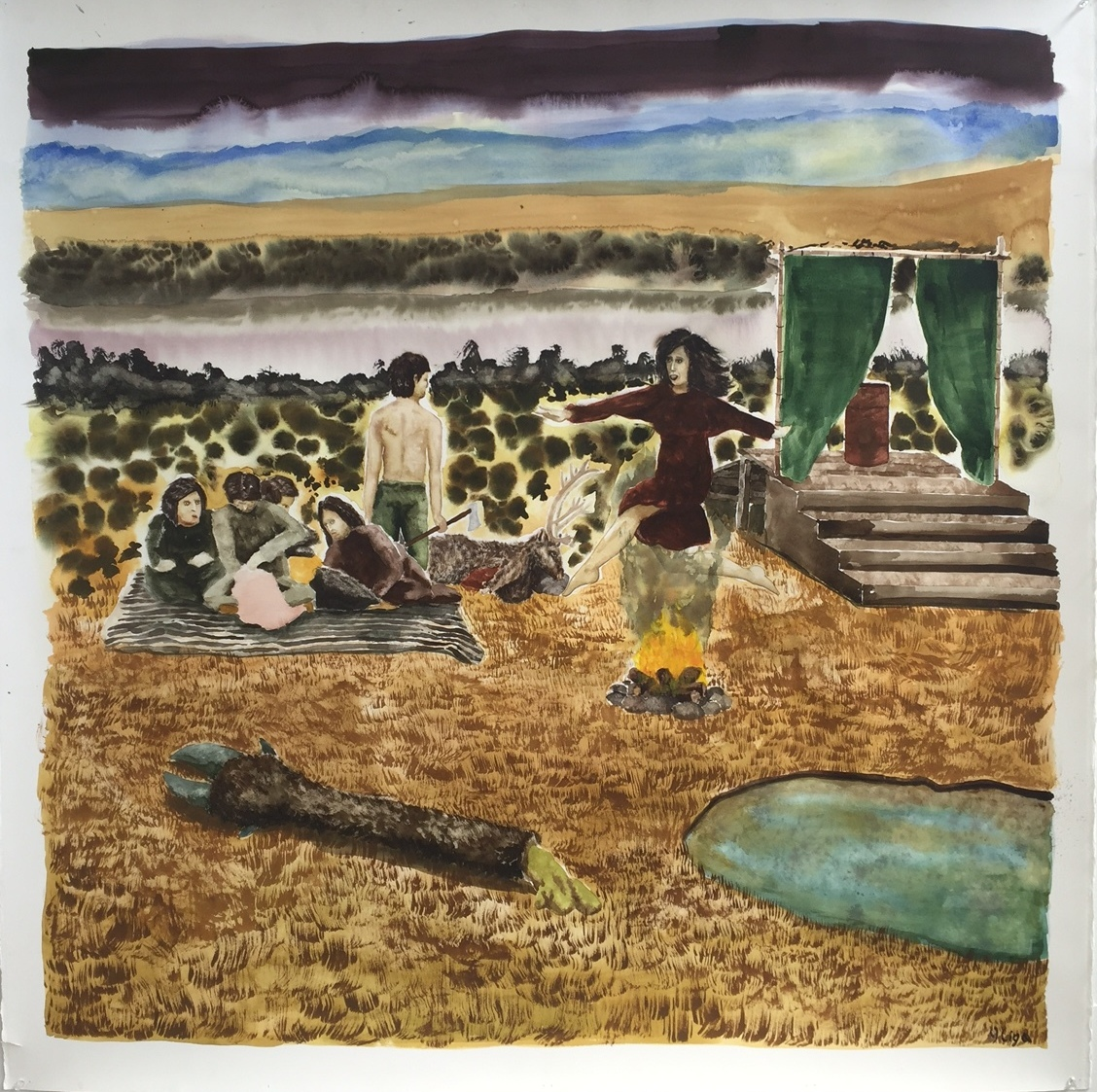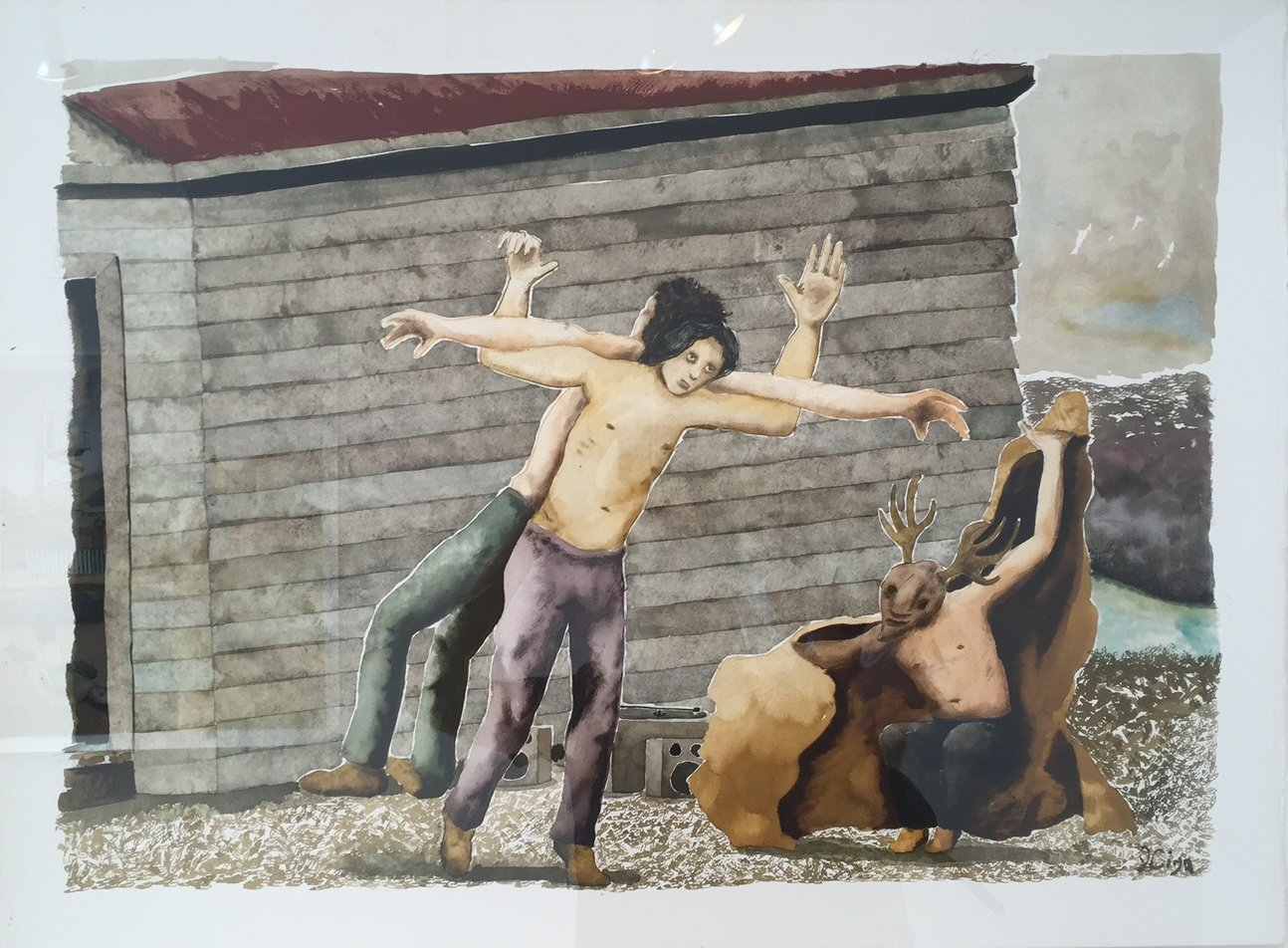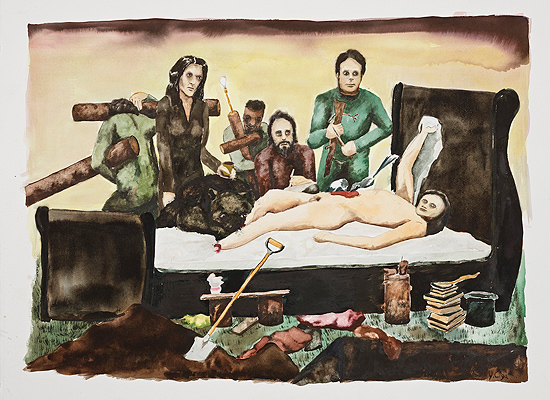 Joseph Tisiga, Improbable Praxis, 2016, watercolour, acrylic, and oil on paper, 51.75” x 51.75”. Photo: Alice Pelot
Joseph Tisiga, Improbable Praxis, 2016, watercolour, acrylic, and oil on paper, 51.75” x 51.75”. Photo: Alice Pelot
Joseph Tisiga’s dark mythologies are narrated through watercolour in correspondence with formats of early colonial documentation in his second solo exhibition at Diaz Contemporary. His chosen scale and pallet were employed 150 years ago to document the Native people across Canada, and the land that was to be settled. By appropriating this style and format Tisiga is able to subvert the context of this first encounter between home and visitor by inserting his contemporary agenda into the historical (and continued) visual fetishization of First Nations culture. As an artist born in Edmonton, Tisiga was raised in a Western tradition, and after becoming connected with his ancestry as Kaska Dene Nation informed his investigation into the complexity of cultural and personal identity.
 Joseph Tisiga, Ritualized Comfort without Historical Authority, 2016, watercolour on paper, 22” x 30”. Photo: Alice Pelot
Joseph Tisiga, Ritualized Comfort without Historical Authority, 2016, watercolour on paper, 22” x 30”. Photo: Alice Pelot
Kent Monkman employs a similar technique of cultural subversion. In the tradition of large-scale history paintings of seascape encounters between Pioneer and Native, hung in National collections, Monkman reimagines/rewrites the shock of Native flamboyancy or the Pioneering boredom. Or conversely, Brian Jungen uses Western materials such as Nike Airs or plastic lawn chairs to produce traditional symbols. Tisiga’s painted scenes are all narrative, storytelling at the height of action, containing traditional threads and allegories as well as personal symbols and subtle Western content.
 Joseph Tisiga, Obscured Provenance, 2016, watercolour, acrylic, and oil on paper, 51.75” x 51.75”. Photo: Alice Pelot
Joseph Tisiga, Obscured Provenance, 2016, watercolour, acrylic, and oil on paper, 51.75” x 51.75”. Photo: Alice Pelot
The bleak landscape scenes – informed in part by Tisiga’s Yukon workspace and Samuel Beckett’s writing – include sections of unnatural gated cut grass; surrealist dreams of Western medicine; allegories of man against man-made nature; Christian symbolism; Classical mythology; sexual scenes; and a man wearing a top hat who seems to represent either an archetype of indigenous man in the modern world or even the artist himself.
 Joseph Tisiga, Liberties on the Verge of Permissiveness, 2016, watercolour on paper, 22” x 30”. Courtesy of Diaz Contemporary
Joseph Tisiga, Liberties on the Verge of Permissiveness, 2016, watercolour on paper, 22” x 30”. Courtesy of Diaz Contemporary
In one particularly confounding painting titled “Conflicting Reflections of Purpose” (2016), a hatless naked man lays in bed outdoors holding high a white sheet of surrender as birds peck at his open stomach and an animal chews off his foot. This figure’s grave is dug in the foreground while behind him one man in scrubs holds a scalpel, one man takes notes and another looms ominously holding a cup. Behind these figures, a man holds a light bulb atop a cross while another struggles with lumber. The mixture of symbols and sources is inscrutable, it is clear which figures and objects are symbols or part of the narrative but with no discernable direction or guidance.
 Joseph Tisiga, Conflicting Recollections of Purpose, 2016, watercolour on paper, 22” x 30”. Courtesy of Diaz Contemporary
Joseph Tisiga, Conflicting Recollections of Purpose, 2016, watercolour on paper, 22” x 30”. Courtesy of Diaz Contemporary
Despite the impenetrability, the complexity of the scenes and the layers of the landscape are captivating. In addition to the watercolours, an installation of Tisiga’s works “The Game is Not a Game” (2016) and three assemblages titles “An Exercise in Resilience 1” (2016) cover an entire wall. There is a clear message “The Game Can Not Be Won” on 26 original blue prints for the construction of residential schools. Even as they are hung around three plywood pieces covered in astro turf and pieces of cut off fur resembling a mini-putt course, it is not clear what the game is and how it might be won.
 Installation view with the The Game Can Not Be Won, 2016 (26 posters, ink on blueprints, 40” x 26.5” each) and An Exercise in Resilience 1, 2016 (Animal furs, astro turf, on plywood, 60” x 60” each). Photo: Alice Pelot
Installation view with the The Game Can Not Be Won, 2016 (26 posters, ink on blueprints, 40” x 26.5” each) and An Exercise in Resilience 1, 2016 (Animal furs, astro turf, on plywood, 60” x 60” each). Photo: Alice Pelot
Nonetheless as a young artist Joseph Tisiga has found an incredible measure of success with work included in Mass MoCA’s exhibition Oh, Canada as well as works in the National Gallery Collection, at the Montreal Museum of Fine Art and in the RBC Collection.
Alice Pelot
*Exhibition information: September 8 – October 8, 2016, Diaz Contemporary, 100 Niagara Street, Toronto. Gallery hours: Tue – Sat, 11 – 6 pm.
